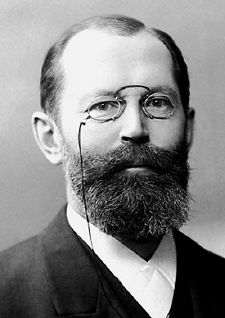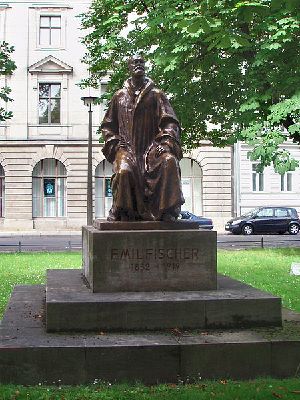Hermann Emil Fischer
|
Emil Fischer | |
|---|---|
 Hermann Emil Fischer | |
| Born |
October 9, 1852 |
| Died | July 15, 1919 |
| Residence | |
| Nationality | |
| Field | Chemist |
| Institutions | University of Munich (1875-81) University of Erlangen (1881-88) |
| Alma mater | University of Bonn University of Strassburg |
| Academic advisor  | Adolf von Baeyer |
| Notable students  | Alfred Stock
Otto Diels |
| Known for | Study of sugars & purines |
| Notable prizes | |
Hermann Emil Fischer (October 9, 1852 - July 15, 1919), better known as Emil Fischer, was a brilliant German chemist who ushered in the age of biochemistry by clarifying the structure of sugars and enzymes and demonstrating the way in which they are formed. He synthesized many naturally occurring substances for the first time, including glucose, caffeine, and uric acid. He synthesized several amino acids and created small chains of them as precursors to protein formation. He suggested the "lock and key" mechanism to explain how enzymes can catalyze certain reactions but not others. He was awarded the Nobel Prize for chemistry in 1902.
Biography
Hermann Emil Fischer was born in Euskirchen, Germany, the son of Laurenz Fischer and Julie Poensgen. He was the youngest of five children, and the only male child. Fischer's father was a merchant, and held out the hope that Fischer could enter the business world. But Fischer's aptitude for and interest in scientific subjects was strong enough to pull him away from his father's work.
Student days
Fischer attended the Gymnasium at Bonn, and graduated at top of his class. In 1871, he began his formal studies in chemistry at the University of Bonn, and transferred to Strasbourg the following year where he studied under Adolf von Baeyer. He was awarded a Ph.D. in 1874 for research on coal tar dyes, after which he assumed a professorship at Bonn.
Professional career
Fischer continued to work with Baeyer, moving to Munich with his mentor in 1875 after Baeyer took over the chair from Justus Von Liebig. He continued research on coal tar dyes with a cousin, Otto Philipp Fischer. In 1878, Fischer served as Associate Professor of Analytical Chemistry. Two years later he accepted a professorship at the University of Erlanger. Around this time, he discovered the compound phenylhydrazine, which he subsequently used in his investigation of sugars.
Purine investigations
He then turned his attention to a group of compounds that shared a chemical base. They could all be derived from purine, which Fischer first predicted the existence of and later synthesized in his laboratory. Purine is now known as one of the important components of nucleic acids that carry the hereditary code in plants and animals. At the time, however, Fischer saw the similarity between purine and other chemicals as more important. He was the first to synthesize caffeine, and was able to create over 100 other compounds that belonged to this class, including uric acid.
In 1884, Fischer became ill from exposure to phenylhydrazine, but recovered a year later. In 1888, he married Agnes Gerlach, the daughter of a professor. The couple had three sons.
During the 1890s, Fischer clarified the chemical structure of the naturally occurring sugars glucose, fructose, and mannose, and synthesized them in 1890.
Proteins and amino acids
Toward the late 1890s, his work turned toward proteins and amino acids. He synthesized several amino acids, and created small chains of amino acids as precursors to protein formation. He identified the structure that links amino acids in a protein, calling it a "peptide" bond. Fischer also suggested that enzymes are able to catalyze certain biochemical reactions and not others because they fit with the substrate they act on like a "lock" and "key" and are therefore very specific. For these and other discoveries, he was awarded the Nobel Prize in chemistry in 1902.
Later career
In his later life, Fischer strengthened the German chemical industry by assisting in the establishment of the Kaiser Wilhelm Socity for the Advancement of Sciences and the Kaiser Wilhelm Institute for Chemistry.
During World War I, Fischer was in charge of Germany's chemical operations, and worked on the synthesis of many substances that the nation no longer had access to because of the Allied blockade. He lost two sons during the war, which is said to have resulted in a major upheaval in his emotional life. A third son, Hermann Otto Laurenz Fischer, who died in 1960, was Professor of Biochemistry in the University of California at Berkeley.
Fischer died July 15, 1919, apparently from stomach cancer. The Emil Fischer Memorial Medal was instituted by the German Chemical Society soon after his death. Fischer's son established the Emil Fischer Library at the University of California in 1952.
Major contributions

Many consider Fischer to be the most brilliant chemist who ever lived, as his numerous contributions to science, especially chemistry and biochemistry. Many chemical reactions and concepts are named after him:
- Fischer indole synthesis
- Fischer projection
- Fischer oxazole synthesis
- Fischer peptide synthesis
- Fischer phenylhydrazine and oxazone reaction
- Fischer reduction
- Fischer-Speier esterification
- Fischer glycosidation
German Chemical Society medals are named after him.
ReferencesISBN links support NWE through referral fees
- Asimov, Isaac. 1982. Asimov's Biographical Encyclopedia of Science and Technology. 2nd ed. New York: Doubleday. ISBN 0385177712
- Ferguson, Pamela. 2002. World Book's Biographical Encyclopedia of Scientists. 8th ed. Chicago: World Book. ISBN 0716676001
- Gillispie, Charles Coulston. 1975. Dictionary of Scientific Biography. New York: Scribner. ISBN 0684101211
- Von Meyer, Ernst. [1906] 2007. A History of Chemistry. tr. George McGowan. Kessinger Publishing, LLC. ISBN 978-0548590645
External links
All links retrieved July 15, 2024.
- Nobel Prize Biography
- Emil Fischer Science History Institute
|
1901: Jacobus Henricus van 't Hoff | 1902: Hermann Emil Fischer | 1903: Svante Arrhenius | 1904: William Ramsay | 1905: Adolf von Baeyer | 1906: Henri Moissan | 1907: Eduard Buchner | 1908: Ernest Rutherford | 1909: Wilhelm Ostwald | 1910: Otto Wallach | 1911: Marie Curie | 1912: Victor Grignard, [Paul Sabatier | 1913: Alfred Werner | 1914: Theodore William Richards | 1915: Richard Willstätter | 1918: Fritz Haber | 1920: Walther Nernst | 1921: Frederick Soddy | 1922: Francis William Aston | 1923: Fritz Pregl | 1925: Richard Adolf Zsigmondy |
Credits
New World Encyclopedia writers and editors rewrote and completed the Wikipedia article in accordance with New World Encyclopedia standards. This article abides by terms of the Creative Commons CC-by-sa 3.0 License (CC-by-sa), which may be used and disseminated with proper attribution. Credit is due under the terms of this license that can reference both the New World Encyclopedia contributors and the selfless volunteer contributors of the Wikimedia Foundation. To cite this article click here for a list of acceptable citing formats.The history of earlier contributions by wikipedians is accessible to researchers here:
The history of this article since it was imported to New World Encyclopedia:
Note: Some restrictions may apply to use of individual images which are separately licensed.